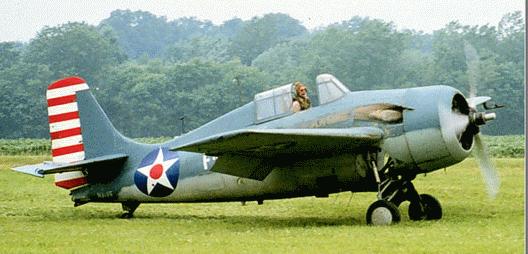
F4F Wildcat (Grumman Aircraft Corp.)

The Wildcat was the standard shipboard fighter of the US Navy at the start of the Pacific War. It has often been said that it was completely outclassed by the Mitsubishi A6M Zero, as the Zero was faster and much more maneuverable than the Wildcat, and included two 20mm cannon in its armament. However, the Wildcat had virtues of its own. It was rugged and reliable, could withstand a great deal of battle damage, and was a very stable gun platform. Its four (later six) 0.5-inch Browning machine-guns were an effective if unspectacular armament. Moreover, the Zero lacked the F4Fs armour and self-sealing fuel tanks. At the Battle of the Coral Sea in May 1942, and at the decisive Battle of Midway 4-6 June 1942, the Wildcat demonstrated that it could fight the Zero on roughly equal terms, even when the Zero was flown by the elite pilots of the Japanese carrier striking force.
| As Japanese losses of trained aircrew mounted, and the
quality of their pilots correspondingly declined, the Wildcat established an ascendancy
over its opponents, which became increasingly evident during the Guadalcanal campaign.
F4Fs inflicted heavy losses on Japanese aircraft during the carrier battles of Eastern
Solomons and Santa Cruz. At Guadalcanal itself, operating from Henderson Field,
Marine Corps F4Fs took a huge toll of enemy aircraft flying from their bastion of
Rabaul. The Wildcats also played a huge part in giving close air support to the US
ground forces on the island. When the F4F's successor - the F6F Hellcat - was introduced it immediately supplanted the Wildcat aboard the Pacific Fleet's fast carriers, but the older F4F was in some ways more suitable for operation from the escort carriers than was the heavier and higher-performance F6F. The Wildcat continued to operate from escort carriers until the end of the war, and gave sterling service. At Leyte Gulf Wildcats flew heroically against the Japanese battleships and cruisers which surprised the Seventh Fleet's escort carriers off Samar. In combination with the Avenger torpedo-bombers which also flew from the tiny carriers - and assisted by the destroyers and destroyer escorts of the carriers' screen - they persistently harassed the superior enemy force and disrupted its attack until the Japanese eventually withdrew. The Wildcat had originally been designed as a biplane, to continue Grumman's F3F series of carrier-borne fighters. The prototype was redesigned - while still on the drawing-board - as a mid-wing monoplane. The resulting prototype XF4F-2 was not successful in competition with the Brewster F2A Buffalo, but Grumman continued development with a more powerful engine, and in early 1939 100 F4Fs were ordered for the French Navy. In August 1939 the US Navy followed with an order for 54. The machines intended for France were diverted to the British Navy, and were there called "Martlets". The F4F-4 - pictured above - was the first version of the Wildcat to have folding wings, a feature which was paricularly useful aboard the cramped jeep carriers. 1,169 F4F-4s were delivered to the US Navy and 220 (as "Martlet IV"s) to the British Navy. Wildcat production was taken over by the Eastern Aircraft Division of General Motors, the GM equivalent of the F4F-4 being designated the "FM-1". Over 1,200 FM-1s were produced. The final mark - the FM-2 - introduced in March 1943, was equipped with a more powerful engine and proved very effective. GM delivered 4,777 FM-2s in just over a year. |

Data below is for the F4F-4
SPECIFICATIONS
Wing Span: 38' 0"
Length: 28' 9" to 28' 11"
Height: 11' 11"
Weight: 4,649 lbs. empty, 6,100 lbs. loaded
Armament
Six .50 cal Browning machine-guns in outer wings; 2 x 250 lb bombs on underwing racks.
PERFORMANCE
Engine: One 1,200 hp Wright R-1830-86 radial
Maximum speed 318 mph
Initial climb approx 1,900 feet per minute
Service ceiling approx 35,000 feet